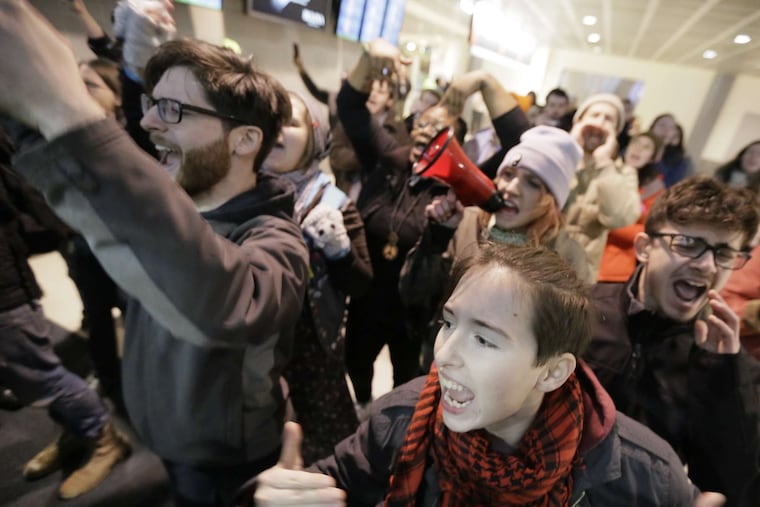A legacy of immigration exclusion and racism followed the tragedy of 9/11 | Opinion
I remember Sept. 11, 2001 as a day of tragedy—and one that normalized a national narrative conflating immigration with terrorism.

During the Sept. 11 terrorist attacks, I lived in Washington, D.C., and worked as an immigration attorney. I remember it as a day of tragedy — and as a day that would normalize a national narrative conflating immigration with terrorism, shift the discourse to “us” vs. “them,” and unleash a litany of immigration policies developed in the name of national security but with negative consequences for Muslim, Arab, and South Asian communities.
After the attacks, some 1,200 men from largely Muslim, Arab, and South Asian countries were swept in what became known by the lawyers, press, and community as a “roundup.” A scathing report by the Department of Justice watchdog examined the conditions and treatment of September 11 detainees held in two facilities: Metropolitan Detention Center and Passaic County Jail. According to the report, the process to name a person a “September 11 Detainee” was broad and often resulted in routine civil immigration charges without demonstrably reducing the risk of terrorism. “September 11 Detainees” at the MDC were locked down 23 hours a day, kept in four-man holds during movement, had restricted phone call and visitation privileges, and had less ability to obtain and communicate with legal counsel.
» READ MORE: Biden ends the ‘Muslim ban’ on day one of his presidency but its impact will linger | Opinion
The roundups may not have persisted, but that policy — and others in that vein — left a disturbing legacy immigration lawyers are still working to undo. A post-9/11 policy known as the “Creppy Memo,” an internal memorandum from Michael J. Creppy in the Justice Department, permitted immigration courts to conduct secret hearings for “special interest” cases, blocking those hearings from family members, press, and the public — and closing more than 600 immigration cases. Another policy, formally the National Security Entry-Exit Registration Program, or NSEERS, involved special registration for Muslims, Arabs, and South Asians. The registry, ultimately discredited by the Department of Homeland Security’s own watchdog, led to deportation papers for nearly 14,000 men and immigration consequences for those who did not register.
Having worked on the ground to fight special registration, write briefs to challenge policies on statutory grounds, and talk to Deferred Action for Childhood Arrivals students both dreaming of and uncertain about the future, I’ve seen the immigration lessons of 9/11 firsthand.
“I would like to see America embrace policies that affirm and include, as opposed to punish or exclude.”
First, executive overreach was a dangerous tool after the attacks — leading to discriminatory rules, guidance, and policy, including the “Muslim bans” barring nationals from seven and later 13 countries from the U.S. for no other reason than place of birth. Executive action has allowed asylum bans at the border, and restrictions for those with DACA status.
A second lesson is the way immigration policies stubbornly discriminate against people based on nationality and race. Even with the “Muslim and African ban” reversed, immigration enforcement impacts Black and brown immigrants differently.
A third lesson is the reality of the limits of courts and congressional action. Courts will not always save us, in part thanks to “plenary power,” a doctrine that favors deference to the “political branches” in immigration matters. Legislation, meanwhile, has faced hurdles in even modestly rolling back post-9/11 policies. The Civil Liberties Restoration Act introduced in 2004, for example, would have codified open hearings (ending the Creppy Memo) in most cases, terminated NSEERs, “administratively closed” (placed on the back burner) removal proceedings for those with available relief, and codified more due process protections for those in detention or facing removal. The CLRA did not become law, in part because of the difficulty of moving legislators who may have felt pressured to label any immigration policy as a national security issue.
» READ MORE: The number of Afghanistan evacuees coming to Philadelphia has doubled in a day to 2,386
Twenty years later, we see legislative efforts to undo executive harms stalling again. The National Origin-Based Antidiscrimination for Nonimmigrants, or NO BAN, Act would have terminated the “Muslim ban” and limited sections of the immigration statute used to create it. The bill passed the House of Representatives twice but has yet to pass in the Senate. Even with the reversal of the “Muslim ban” the NO BAN Act remains important to prevent similar restrictions in the future and improve transparency.
A final lesson is that reversing or ending immigration policy does not end the pain nor erase the human impact on individuals and families — which included missed milestones, family separation, and ongoing financial or administrative hurdles that prevent entry to the United States.
Moving forward, the Biden administration must address this harm with flexibility, recognizing there is no single route for immigration reform, and adopt a legal and policy framework that considers the factors driving disparate immigration enforcement. I would like to see America embrace policies that affirm and include, as opposed to punish or exclude.
Shoba Sivaprasad Wadhia is associate dean for diversity, equity, and inclusion at Penn State Law, where she is also clinical professor of law and founder and director of the Center for Immigrants’ Rights Clinic.